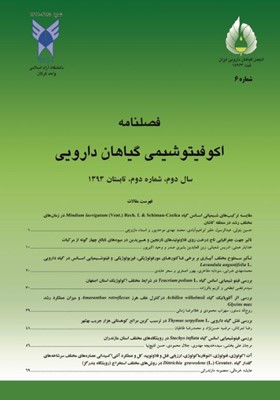مقایسه ترکیبهای شیمیائی اسانس گیاه Mindium laevigatum (Vent.) Rech. f. & Schiman-Czeika در زمانهای مختلف رشد در منطقه کاشان
محورهای موضوعی : اکولوژی محیطیحسین بتولی 1 * , عبدالرسول حقیر ابراهیم آبادی 2 , محمد مهدی موحد پور 3 , اسماء مازوچی 4
1 - استاد یار-مرکزتحقیقات کشاورزی ومنابع طبیعی استان اصفهان (باغ گیاه شناسی کاشان )
2 - دانشیار -پژوهشکده اسانس های طبیعی اسانس های طبیعی -دانشگاه کاشان
3 - کارشناس شیمی وفن آوری اسانس های طبیعی -دانشگاه کاشان
4 - کارشناس ارشد -پژوهشکده اسانس های طبیعی -دانشگاه کاشان
کلید واژه: اسانس, ترکیبهای شیمیائی, پالمیتیک اسید, گل استکانی, گل شکافته,
چکیده مقاله :
جنس "گل شکافته"(Mindium L.) متعلق به تیره گل استکانی (Campanulaceae)، دارای گونههای بوتهای متعددی است که تاکنون بالغ بر 7 گونه از این جنس در جهان و 3 گونه از ایران گزارش شده است. در این تحقیق ترکیبهای شیمیائی اسانس اندامهای رویشی و زایشی گیاه "گل شکافته" (Mindium laevigatum (Vent.) Rech. f. & Schiman-Czeika)واقع در دو رویشگاه رهق و شهسواران کاشان مورد بررسی قرار گرفته است. ساقه و میوههای رسیده این گیاه در بهار سال 1390 جمعآوری و در شرایط آزمایشگاه خشک شدند و به روش تقطیر و استخراج با بخار همزمان با حلال آلی (SDE) اسانسگیری شدند. برای شناسائی ترکیبهای تشکیلدهنده اسانس، از دستگاههای گاز کروماتوگرافی (GC) و گاز کروماتوگرافی متصل شده به طیفسنج جرمی (GC/MS) استفاده شد. تعداد 43 ترکیب شیمیایی در اسانس میوه و 34 ترکیب در اسانس ساقههای گیاه رویشگاه رهق شناسائی شدند. 42 ترکیب شیمیایی در اسانس میوه و 44 ترکیب در اسانس ساقههای گیاه رویشگاه شهسواران شناسایی شد. اجزای اصلی اسانس میوه گیاه در رویشگاه منطقه رهق شامل: هنیکوزان (58/9%)، پالمیتیک اسید (41/7%)، پی-وینیل گوائیکول (97/4%) و دی هیدروکاروئول (47/4%) بودند. اجزای اصلی اسانس ساقه گیاه در رویشگاه منطقه رهق شامل: پالمیتیک اسید (93/30%)، لینولئیک اسید (32/10%)، میرستیک اسید (97/5%) و پلارگونیک اسید (25/4%) بودند. ترکیبهای عمده اسانس میوه گیاه رویشگاه منطقه شهسواران شامل: لینولئیک اسید (63/18%)، پالمیتیک اسید (13/14%)، هنیکوزان (47/7%) و نونادکان (52/3%) بودند. اجزای اصلی اسانس ساقه گیاه رویشگاه منطقه شهسواران شامل: پالمیتیک اسید (67/33%)، لینولئیک اسید (56/6%)، اتیل پالمتات (32/5%) و اوژنول (14/3%) بودند. بیشترین اجزاء تشکیلدهنده اسانس اندامهای رویشی و زایشی گیاه گلشکافته موجود در دو رویشگاه، ترکیبهای مومی و سنگین بودند.
1.Adams, R.P. 2007. Identification of Essential Oil Components by Gas Chromatography-Mass Spectrometry, Allured Publishing Corporation, USA, 4th Ed., pp: 804.
2.Aghabigi, F., Jalilian, N., Assadi, M., and Maassoumi, A.A. 2009. Flora of Iran: Campanulaceae family, Publishing of Research Institute of Forests and Rangelands. 66: 126. (In Persian).
3.Aslan, S., Vural, M., Şahin, B., Ergin, E., and Kaya, O.F. 2010. A new record for Turkey: Michauxia nuda A. DC. (Campanulaceae), Turk. J. Bot., 34: 51-56.
4.Batooli, H. 2003. Biodiversity and species richness of plant elements in Qazaan reserve of Kashan. Pajouheh & Sazandegi. 61(4):85-103. (In Persian).
5.Baytop, T. 1999. Turkiye’de bitkiler ile tedavi, gecmiste ve bugun. Nobel Tıp Kitabev-leri, pp: 480.
6.Becker, L.C., Bergfeld, W.F., Belsito, D.V., Hill, R.A., Klaassen, C.D., Marks, J.G., Shank, R.C., Slaga, T.J., Snyder, P.W., and Andersen, F.A. 2010. Final report of the amended safety assessment of myristic acid and its salts and esters as used in cosmetics, Int. J. Toxicol. 29 (Suppl 3):162-186.
7.Bernas, A., Myllyoja, J., Salmi, T., Yu. and Murzin, D. 2009. Kinetics of linoleic acid hydrogenation on Pd/C catalyst, Appl. Catal. A-Gen., 353(2): 166–180.
8.Davies N.W. 1990. Gas Chromatographic Retention index of monoterpenes and sesquiterpenes on methyl silicone and carbowax 20 m phases. Journal of Chromatogr. 503: 1-24.
9.Gahreman, A. 1989. Cormophytes of Iran (Plants systematic), 1th edition, Publisher of university central, Tehran, 3: 842. (In Persian).
10.Guvenc, A., Akkol, E.K., Hurkul, M.M., Suntar, I., and Keles, H. 2012. Wound healing and anti-inflammatory activities of the Michauxia L’Herit (Campanulaceae) species native to Turkey, J. Ethnopharmacol., 139, 401– 408.
11.Heywood, V.H., Brummitt, R.K., Culham, A., and Seberg, O. 2007. Flowering plants families of the world. Firefly books, ontario, Canada. pp: 410.
12.Jaffari Kokhdan, A. 1994. A study of taxonomic of Campanulaceae family in Iran, Master's thesis of plant systematic, University of Tehran, pp: 189 (In Persian).
13.Kamphuis, M.M.J.W., Saris W.H.M. and Westerterp-Plantenga, M.S. 2003. The effect of addition of linoleic acid on food intake regulation in linoleic acid tasters and linoleic acid non-tasters, Br. J. Nutr, 90: 199–206.
14.Larmo, P., Yang, B., Judin, V.P., and Ulvinen. T. 2011. Sea Buckthorn Oil for skin health and Beauty from Within, Aromtech Ltd, Tornio, Finland. pp: 7.
15.Micozzi, M.S. 2007. Complementary and integrative medicine in cancer care and prevention: foundations and evidence-based interventions, Springer Pub. Co, 1st ed. New York, pp: 457.
16.Mitsui, T. 1998. New Cosmetic Science, Elsevier Science, New York, pp: 126.
17.Morteza-Semnani, K., Saeedi, M., and Akbarzadeh, M. 2008. The essential oil composition of Asyneuma pulchellum. Chemistry of Natural Compounds, 44: 787–788.
18.Mosaddegh, M., Naghibi, F., Moazzeni, H., Pirani, A., and Esmaeili, S. 2012. Ethnobotanical survey of herbal remedies traditionally used in Kohghiluyeh VA Boyer Ahmad province of Iran, J. Ethnopharmacol., 141: 80– 95.
19.Mozaffarian, V. 1996. A Dictionary of Iranian Plant Names. Farhang Moaser Publisher, Tehran, pp: 750. (In Persian).
20.Mozaffarian, V. 1998. Flora of Ilam. Farhang Moaser Publisher, Tehran, pp: 936. (In Persian).
21.Shibamoto, T. 1987. Retention indices in essential oil analysis: 259-274. In: Sndra, P. and Bicchi, C., (Eds.). Capillary gas chromatography in essential oil analysis. verlagsgruppe huthig jehle Rehm GmbH, New York, pp:435.
22.Tosun, G., Kahriman, N., Çoskunçelebi, K., Genç, H., Karaoglu S.A. and Yayli, N. 2012. Chemical composition and biological activity of the essential oil of campanula olympica boiss., Asian J. Chem., 23(6): 2389–2391.
23.Touafek, O., Kabouche, Z., Brouard I., and Barrera Bermej, J. 2011. Flavonoids of Campanula alata and their antioxidant activity, Chemistry of Natural Compounds, 46(6): 968-970.
24.World Health Organization technical report series No. 557. 1974. Evaluation of certain food additives eighteenth report of the joint FAO/WHO expert committee on food additives. Published by FAO and WHO. Geneva. pp: 39.
25.Zargari, A. 1995. Medicinal plants. Tehran University Publications, 3: 947. (In Persian).

